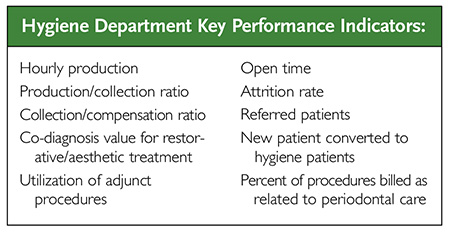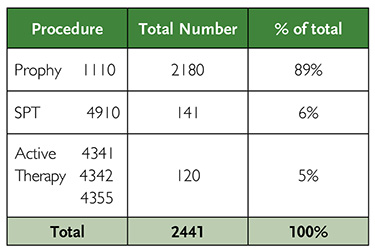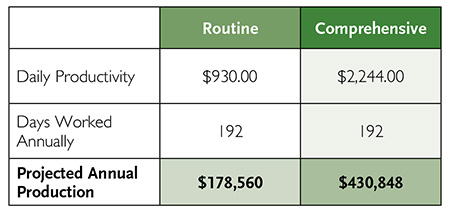
The potential impact of a highly empowered hygiene department is almost limitless. As business owners, we are constantly looking for ways to improve and enhance the cash flow generated by the business. There is untapped potential in the hygiene departments of every practice and to capitalize on them, think comprehensively. When you empower the hygiene department and train them to think more comprehensively, your revenue stream grows. Consider the hygiene department in terms that go beyond a P&L statement. An effective hygiene department also functions as a highly skilled diagnostic center, an integrative marketing source and a communications hub that drives almost every successful dental office. The key to unlocking the potential of this department is related to your leadership as a dentist and your ability to foster an empowering office culture. The critical things to do include: hiring talented people who share your vision and working together to find areas of growth within your practice. An often overlooked aspect is to making your hygiene department a key part of your growth strategy. Read on to identify critical leadership characteristics, define key department performance indicators, recognize current diagnostic and technological tools, and introduce the communication and marketing tools that are necessary to propel your hygiene department to its greatest potential.
Leadership and Organizational Behavior
Leadership, as defined by Peter Drucker (a management consultant, educator, and author) is,“Lifting a person’s visions to high sights, the raising of a person’s performance to a higher standard, the building of a personality beyond its normal limitations.”
Consider the key words that identify components of a high-performing team: vision, performance, high standards and personality beyond limitations. Don’t overlook those critical aspects. First and foremost, a practice must possess the leadership and organizational behavior required to attain a highly empowered hygiene department. As an owner, you must articulate a clear vision, provide a safe learning environment, be open to change, yet decisive with the direction of the practice and hire talent that allows you to execute strategies. When hiring team members, look beyond the clinical skill sets highlighted on resumes. High-performing team members should also possess certain competencies: innovation, commercial awareness, technological orientation, drive for excellence, customer focus, flexibility, organization, reliability, influence, integrity and respect for others. A great tool is the Sixteen Personality Factor questionnaire, developed by psychologist Raymond Cattell. The 16PF® Assessment can help to identify competencies as well as provide leaders with tools to develop the potential within the hygiene department. Creating a baseline measurement for employees by utilizing resources like the 16PF® questionnaire is the first step forward. (For more information, visit http://www.ipat.com/about/16pf/Pages/default.aspx)
Key Performance Indicators
Once leadership has an idea of the organization’s characteristics, the next step is identifying key performance indicators (KPIs) and realistic benchmarks. It is hard to hit the mark if you don’t know what the target looks like and establishing KPIs that describe your goals is a key part of effective management. Define your KPIs and employ analytics to measure trends related to those KPIs. It is imperative that each hygienist understands and records the KPIs as they relate to productivity and growth. A key point of failure for most KPIs is the failure to communicate to staff members about what the KPI is measuring. For this reason, I like to make sure that the hygienists are involved in the definition of the KPIs. Monthly, quarterly, and annual meetings are recommended to keep team members updated, motivated and informed of emerging trends. When necessary, adjust strategies as the KPIs indicate trends that can be capitalized on.
While not necessarily a KPI in the traditional sense, be aware of the overutilization of the D1110 code and the underutilization of the D4341, D4342 and D4910 codes. This imbalance stems from periodontal disease going unrecognized and untreated. To determine how well your practice is diagnosing periodontal disease, generate the following report from your dental software: identify the percent of procedures billed out in 2012, then compare your statistics to the percentages to the chart below.
Example of a Billed Procedures Report for 2012
The new report not only provides an accurate representation of the office’s recognition of periodontal disease, but also serves as a growth predictor. The report is the basis for determining future hygiene capacity as well as optimal financial growth. To successfully shift from the pie chart labeled “actual” to the pie chart labeled “goal,” the following should be employed:
• Standardized definition of healthy
• Integration of treatment protocols designed to
control periodontal infections and the
inflammatory aspects of the disease
• The entire team must understand and
promote the philosophy
• Effective case presentation to increase case
acceptance
• Technological investments
Example of a Billed Procedures Pie Chart for 2012
Optimize Clinical Protocols
To attain and sustain growth within the hygiene department, a constant awareness of current and emerging technologies is essential. Technology is advancing at an exponential rate so it is critical that the hygiene department members have innovation as one of their characteristics on the personality questionnaire. In order to create sustained growth and improvement, a practice must possess a “change oriented culture,” with protocols designed to establish clinical continuity, leadership and accountability. Since the focus of this article is the hygiene department, look at the technologies available today that allow many hygiene departments to raise not only their productivity and profitability but also their standard of care.
Products to Empower Your Hygiene Department
Adopting new technologies is about being on the “cutting edge.” It is also about providing more comprehensive care while managing costs and creating additional revenue. The table below compares the difference between a routine and comprehensive hygiene approach. The comprehensive approach makes use of technologies that many dental practices may have, but underutilize. Pay special attention to the D4910L, D4341L codes which make use of a laser. The net effect on your productivity as evidenced by the charts below is significant.
Comparison of Daily Revenue for Routine vs. Comprehensive Hygiene
Comparison of Yearly Revenue for Routine vs. Comprehensive Hygiene
Communication and Marketing Tactics
In todayʼs highly competitive world, it is not enough to be a great clinician. To thrive in our industry, you must also excel in communication and marketing tactics. That simply means that you must understand and control the messages that you are sending to the general public and to your patients. Patients and potential patients are constantly bombarded with information and offers from dental practices. They can become “blind” to the differences between a great dental practice and a run-of-the-mill one. Often, the messaging is so convoluted or complex that they fall back on the most natural decision making strategy—price. In this article, I have focused mostly on the internal communication and marketing tactics that your hygiene department should use to ensure that your message is resonating. Essential components of an effective messaging strategy are:
• Adoption of a systematic communication strategy like the 16PF® or which will empower staff to better understand one another and connect with patients in a meaningful way.
• Participate in and assist in developing an effective “Patient Care Meeting.” These types of daily meetings allow staff to review the needs and concerns surrounding upcoming patients and discuss month-to-date KPIs and marketing strategies.
• Develop team awareness to enhance product knowledge and increase sales ratios
• Actively participate in the development of the messages that are the core of your marketing efforts.
• Train hygiene staff to properly ask for referrals and encourage patients to promote/endorse the practice.
• Make sure that the staff feel that they can contribute to the content for your social media campaigns and your website.
• Look for opportunities to gather patient testimonials that affirm the messages you want to promote.
• Enhance perceived value of your practice and your brand by providing informational presentations to your community.
The potential of an empowered hygiene department is limitless. The best part is that the outcome is both a win for the practice and the patient—the practice is more profitable and the patient is getting a level of care that will ensure their health and well being. The ability to make this happen is something that all dental practices potentially possess. If you empower the hygiene department, commit to continuous learning and communicate effectively, you will be successful and your patients will be healthier.
To hear Gwen Smukowski’s recent webinar on “The How And Why of Lasers In Dental Hygiene” click here















